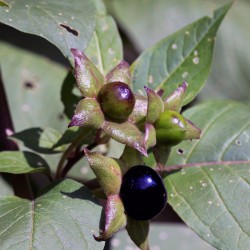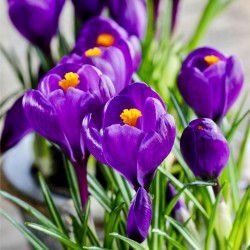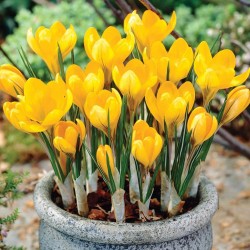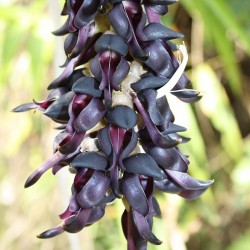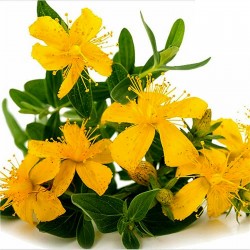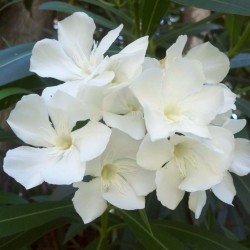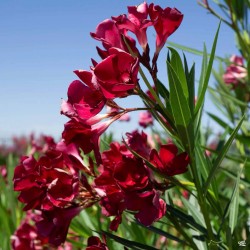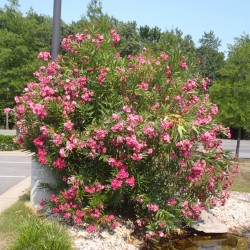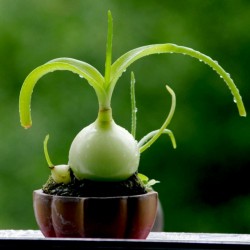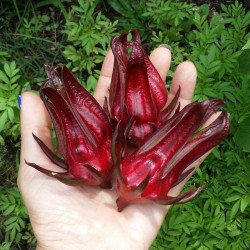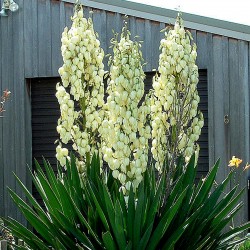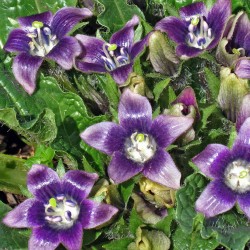
Alruin Zaden (Mandragora...
Prijs
€ 15,00
SKU: MHS 16
Seeds Gallery Com,
5/
5
<meta http-equiv="Content-Type" content="text/html; charset=UTF-8" />
<h2><strong>Alruin Zaden (Mandragora officinarum)</strong></h2>
<h2><span style="color: #ff0000;"><strong>Prijs voor pakket met 5 zaden.</strong></span></h2>
<p>De<span> </span><b>alruin</b><span> </span>(<i>Mandragora officinarum</i>) is een<span> </span>overblijvend kruid<span> </span>uit de<span> </span>nachtschadefamilie<span> </span>(<i>Solanaceae</i>). De soortaanduiding<span> </span><i>officinarum</i><span> </span>betekent dat de plant tijdens haar naamgeving op lijsten van planten met geneeskrachtige eigenschappen voorkwam. De plant wordt nu niet meer als zodanig gebruikt.</p>
<h2><span class="mw-headline" id="Etymologie">Etymologie</span></h2>
<p>De precieze<span> </span>etymologie<span> </span>is complex en omstreden. De Nederlandse naam alruin is mogelijk afgeleid van die van een 11e-eeuwse filosoof, astroloog, reiziger, historicus en drogist genaamd<span> </span>Al-Biruni. De<span> </span>Arabische<span> </span>naam 'luffâh' of 'beid el-jinn' betekent 'ei van de geest'.</p>
<h2><span class="mw-headline" id="Botanische_beschrijving">Botanische beschrijving</span></h2>
<p>De<span> </span>peterselie-achtige, grote, bruine<span> </span>penwortel<span> </span>is vaak vertakt of gevorkt en dringt diep in de grond door. Boven de grond ontspruit hieruit een<span> </span>bladrozet<span> </span>van ovale, ingesneden bladeren van 15 centimeter breed en 40 centimeter lang. Deze bladeren staan in het begin rechtop; later spreiden ze zich plat uit.</p>
<p>De plant draagt groen-witte of lichtblauwe, 5 centimeter grote, klokvormige bloemen op afzonderlijke stelen. De bloeiperiode valt in de periode maart tot april. Uit deze bloemen ontstaan in het late voorjaar oranje tot rode<span> </span>bessen, die enigszins op<span> </span>tomaten<span> </span>lijken.</p>
<p>De plant sterft bovengronds in het najaar af. De ondergrondse wortels overleven de winter en lopen in het voorjaar opnieuw uit.</p>
<h2><span class="mw-headline" id="Voorkomen">Voorkomen</span></h2>
<p>De alruin komt van nature voor in<span> </span>Zuid- en<span> </span>Midden-Europa<span> </span>en in het<span> </span>Middellandse Zeegebied, waar zij onder andere op<span> </span>Corsica<span> </span>kan worden aangetroffen.</p>
<h2><span class="mw-headline" id="Medicinaal_en_ander_gebruik">Medicinaal en ander gebruik</span></h2>
<div class="thumb tright">
<div class="thumbinner"><img alt="" src="https://upload.wikimedia.org/wikipedia/commons/thumb/8/8d/Mandrake-roots.jpg/260px-Mandrake-roots.jpg" decoding="async" width="260" height="395" class="thumbimage" srcset="//upload.wikimedia.org/wikipedia/commons/thumb/8/8d/Mandrake-roots.jpg/390px-Mandrake-roots.jpg 1.5x, //upload.wikimedia.org/wikipedia/commons/thumb/8/8d/Mandrake-roots.jpg/520px-Mandrake-roots.jpg 2x" data-file-width="576" data-file-height="876" />
<div class="thumbcaption">
<div class="magnify"></div>
De wortel</div>
</div>
</div>
<p>De alruinwortel bevat giftige<span> </span>alkaloïden<span> </span>(scopolamine,<span> </span>atropine,<span> </span>apoatropine,<span> </span>hyoscyamine,<span> </span>cuskhydrine,<span> </span>solandrine,<span> </span>mandragorine<span> </span>en andere<span> </span>hallucinogene<span> </span>tropaanalkaloïden). De plant werd vroeger als<span> </span>narcoticum<span> </span>en<span> </span>pijnstiller, en deels ook als hallucinogeen middel gebruikt, onder meer in<span> </span>heksenzalf.</p>
<p>In de<span> </span>Oriënt<span> </span>werd de plant beschouwd als middel om conceptie te verzekeren; dit komt tot uiting in de<span> </span>Hebreeuwse<span> </span>naam,<span> </span><i>dud‘</i><span> </span>of<span> </span><i>dudaim</i><span> </span>(liefdesplant), een verwijzing naar het<span> </span>Bijbelverhaal<span> </span>in Genesis hoofdstuk 30, waarin<span> </span>Rachel<span> </span>deze plant probeerde te gebruiken omdat zij onvruchtbaar was en haar man Jakob graag een zoon wilde geven.<sup id="cite_ref-1" class="reference">[1]</sup></p>
<h3><span class="mw-headline" id="Anesthesie">Anesthesie</span></h3>
<p>Dioscorides<span> </span>verwijst naar het gebruik van de plant als<span> </span>anestheticum<span> </span>bij het verdoven van patiënten die gesneden of verbrand zijn.</p>
<p>Plinius de Oudere<span> </span>refereert aan de geur van de alruin als slaapverwekkend wanneer ze genomen werd voordat een insnede werd toegepast.</p>
<p>Lucianus van Samosata<span> </span>spreekt over het gebruik van de plant voordat het brandijzer werd gebruikt.</p>
<p>Claudius Galenus<span> </span>noemt de plant terloops in verband met haar macht om gevoel en bewegingen te verlammen.</p>
<p>Isidorus van Sevilla<span> </span>zou gezegd hebben: "De wijn in de bast van de wortel wordt gegeven aan hen die een operatie ondergaan zullen opdat ze geen pijn zullen voelen in hun slaap".</p>
<p>Ugone da Lucca<span> </span>ontdekte in de 12e eeuw een stof die, wanneer ingeademd, de patiënten in slaap brengt zodat zij tijdens een operatie geen pijn voelen; het is bekend dat hij hiermee de alruin bedoelde.</p>
<p>Reeds in 1830 gebruikte de Japanse arts<span> </span>Seishu Hanaoka<span> </span>een verdovend extract uit de alruin in de<span> </span>heelkunde.<span> </span>Ernst Schmidt<span> </span>ontdekte in 1888 scopolamine in de alruin.</p>
<h3><span class="mw-headline" id="Heksenkruid">Heksenkruid</span></h3>
<p>Door de hallucinogene effecten speelt de plant een belangrijke rol in<span> </span>magie<span> </span>en<span> </span>hekserij. Alruin wordt daar gezien als een<span> </span>heksenkruid<span> </span>en is een bestanddeel van allerlei heksendrankjes en heksenzalf. Er werd grote<span> </span>toverkracht<span> </span>aan toegeschreven.</p>
<h2><span class="mw-headline" id="Cultuurgeschiedenis_van_alruin">Cultuurgeschiedenis van alruin</span></h2>
<p>Doordat de wortel van de alruin veel vertakkingen heeft, vertoont die met een beetje fantasie vaak gelijkenis met een menselijk lichaam. De Griekse wijsgeer<span> </span>Pythagoras<span> </span>beschreef de wortel al als een 'miniatuurmensje'. Door deze gelijkenis geloofde men in de middeleeuwen (volgens de<span> </span>signatuurleer) dat de wortel bovennatuurlijke macht had over de menselijke geest en het lichaam.</p>
<p>Christenen<span> </span>zagen in de wortel een probeersel van de mens van<span> </span>God. Een op de mens lijkende wortel van de alruin werd in de<span> </span>middeleeuwen<span> </span>als wondermiddel beschouwd. Het zou de vruchtbaarheid kunnen bevorderen en magische krachten bezitten. Ook werd de wortel van de<span> </span>heggenrank<span> </span>vaak als alruin verkocht.</p>
<p>De wortels van de alruin werden vaak door mensen bewerkt en besneden zodat zij nog meer op een menselijke gestalte gingen lijken. Het bedrog was bijzonder lucratief.<sup id="cite_ref-2" class="reference">[2]</sup></p>
<h3><span class="mw-headline" id="Alruin_in_oude_verhalen">Alruin in oude verhalen</span></h3>
<p>Al vroeg was men buitengewoon voorzichtig om alruin uit de grond te trekken. Theophrastus schreef er in de derde eeuw voor Christus over dat verzamelaars van deze plant er eerst cirkels omheen trokken en dan de top eraf sneden terwijl ze naar het westen keken. De rest van de wortel werd dan geoogst na het zeggen van speciale formules en het dansen van bepaalde dansen.</p>
<p>Later gebruikte men honden voor het oogsten van de wortel, want men geloofde dat de ijzingwekkende schreeuw die daarbij zou klinken een mens het leven kon kosten. Men stopte dan zelf de oren dicht met bijenwas, zodat de dodelijke schreeuw niet te horen was. De plant diende nergens direct aangeraakt te worden: dit zou ook de dood tot gevolg hebben. De hond moest dan diepzwart zijn, de kleur van het kwade en de dood. Behalve de hond werden dan een stuk vlees, een stuk touw en een zilveren schop meegebracht naar de plant. De grond om de plant werd weggeschept, zodat de wortel bloot kwam te liggen. Dan bond men het touw aan de plant vast, en aan de hond. De hongerige hond werd dan gelokt met het stuk vlees, zodat het dier aan het touw trok en daardoor de plant uit de aarde haalde. De hond zou dan doodvallen door de schreeuw van de plant, maar de plantentrekker zou in leven blijven door de bijenwas in zijn oren.</p>
<p>Volgens het volksgeloof groeide de plant alleen op plaatsen waar ooit een galg had gestaan en groeide ze op het lijkvocht, de urine en het zaad van een (onschuldige) gehangene. Vandaar dat in Duitsland de plant ook "galgenmannetje" werd genoemd.</p>
<h3><span class="mw-headline" id="Bijbelse_plant">Bijbelse plant</span></h3>
<p>Alle uitleggers beschouwen<span> </span><i>Mandragora officinarum</i><span> </span>als de plant bedoeld in<span> </span>Gen<span> </span>30:14 (liefdesappelen), en<span> </span>Hooglied<span> </span>7:14.<sup class="noprint nopopups"><span title="Voor deze uitspraak is sinds 15 september 2009 een bronvermelding gewenst. Motivering: De twee zinnen hierna suggereren dat er voor alruin als Bijbelse liefdesappel wél bevredigend bewijs zou zijn. Als dat er is, zou ik dat als bronvermelding vermeld zien. Sjabloon geplaatst door ITSME">[bron?]</span></sup><span> </span>Er zijn veel andere planten hiervoor gesuggereerd, zoals<span> </span>bramen,<span> </span><i>Zizyphus lotus</i>, het<span> </span><i>sidr</i><span> </span>van de Arabieren, de<span> </span>banaan, de<span> </span>lelie, de<span> </span>citroen<span> </span>en de<span> </span>vijg, maar geen hiervan wordt door bevredigend bewijs ondersteund.</p>
<h3><span class="mw-headline" id="Machiavelli">Machiavelli</span></h3>
<p>In 1520 schreef<span> </span>Niccolò Machiavelli<span> </span>een<span> </span>komedie<span> </span>genaamd<span> </span><i>La mandràgola</i>.</p>
MHS 16 (5 S)





